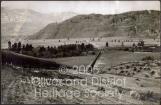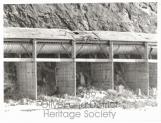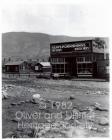1
The ditch carried water from Vaseaux Lake, across the valley, and along the cliffs beside Gallagher Lake. Raised flumes carried the water across sections which were deemed unsuitable for an in-ground canal.2
Picture of Flume #120th Century, Circa 1920's
Oliver, British Columbia, Canada
 Credits:
Credits:Johnstone, James Cameron
3
Some portions of the canal concern engineers to this day, especially in the interface between the mountains and the canal. Rockslides could mean havoc for citizens relying on the canal's supply.4
Crack in mountain wall near flume #120th Century, Circa 1920's
Oliver, British Columbia, Canada
 Credits:
Credits:Johnstone, James Cameron
5
A major problem to be overcome was: once the water was distributed to the eastern side of Oliver, how could it cross the valley without disturbing the townsite? An ingenious solution was thought up; an inverted siphon would carry water beneath the town to the west side.6
Syphon during construction20th Century, Circa early 1920's
Oliver, British Columbia, Canada
 Credits:
Credits:Johnstone, James Cameron
7
At completion, the siphon measured nearly three-quarters of a mile across the valley. During the winter months, it was a popular walkway for young couples seeking privacy and romance in the dark tunnel, and youth frequently rode bicycles through the tunnel.8
Southern Okanagan Irrigation Works Syphon at Fairview20th Century, Circa 1920
Oliver, British Columbia, Canada
 Credits:
Credits:Johnstone, James Cameron
9
Safety along the rocky cliffs was a constant concern, as was the integrity of the ditch. Inspectors and engineers worked alongside construction crews to ensure consistent quality and stability.10
Inspectors at Southern Okanagan Irrigation Project camp20th Century, Circa 1920's
Oliver, British Columbia, Canada
 Credits:
Credits:Johnstone, James Cameron
11
Construction on the canal was not without hazard, however. Along McIntyre Bluff and the Gallagher Lake cliffs, rockslides were a regular occurrence. Wooden covering was put into place to try and protect the flumes and canal, but these proved insufficient on their own. Eventually, the paneling would be augmented by a complete gravel covering, which exists to this day.12
Damage to the Flume caused by cliff debris20th Century, 1940-1970
Oliver, British Columbia, Canada
 Credits:
Credits:Southern Okanagan Lands Project
13
As construction of the canal progressed, and more land became available for agriculture, the town steadily grew. Some people did not come to the Oliver townsite to establish farms. Services and businesses began to develop, appealing to construction workers and farmers alike.14
East side of Oliver mainstreet showing Gent's Furnishings20th Century, Circa 1920's
Oliver, British Columbia, Canada
 Credits:
Credits:Mrs. Mabee, George